Aloe transplant
The plant has to “change living space” if:
- Land renewal is required, as it has already been depleted over the years of aloe growth;
- Aloe roots have rotted from over-watering;
- It has grown too much, sits very tightly in the pot and sprouts outward with its roots.
Young aloes grow very quickly at home, so they need to be transplanted once a year. Over time, the growth rate of the plant slows down and upon reaching 5 years of age, adults are transplanted aloe only once every 3 years.
The new pot should be taller and wider than the previous one. Attach it visually to the plant: let the planter be the same height as the aloe itself from the ground to the top (see photo below).
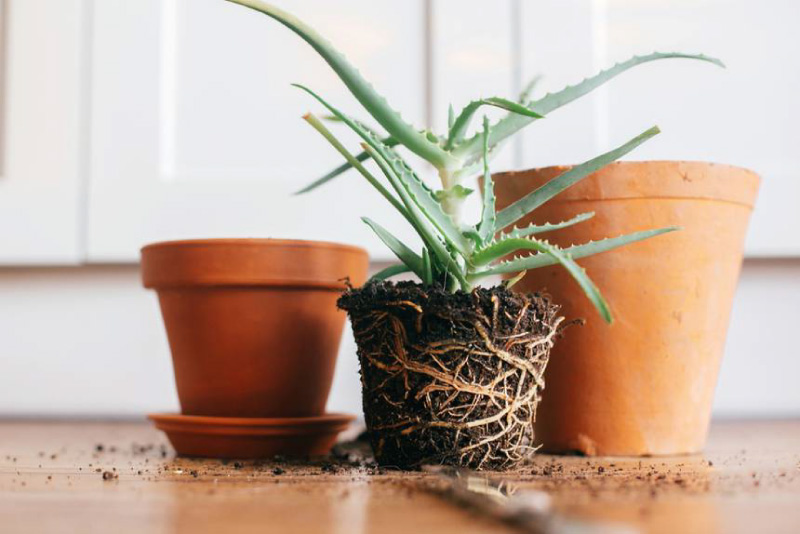
It's great if you already have soil for cacti and succulents: it's perfect for aloe. If the house has only universal soil, it is better to mix it with sand in a ratio of 1: 4.
Another important nuance: it is advisable to transplant aloe only in spring or summer. Otherwise, the plant may not survive stress and die.
Here are step-by-step instructions for transplanting an aloe.
How to transplant aloe at home
Step 1. Place the drainage stones on the bottom of the new pot.
Step 2. Pour a few centimeters of earth (not to the top).
Step 3. Gently "roll over" the aloe and take it out of the pot, trying not to injure the roots.
Step 4. Install in a new planter, clearly in the middle and not overwhelming on the side.
Step 5. Holding the base with one hand, fill the void with earth.
Step 6. Move the aloe to partial shade for a couple of weeks.
Step 7. Watering three days after transplanting, do not touch while the leaves.
In case of decay of the roots, in no case do we plant from the old into a new pot without processing the root system. To do this, we carefully clean off the ground, examine the roots, remove the sick, wash the healthy ones, and only after that we carry out the transplant.
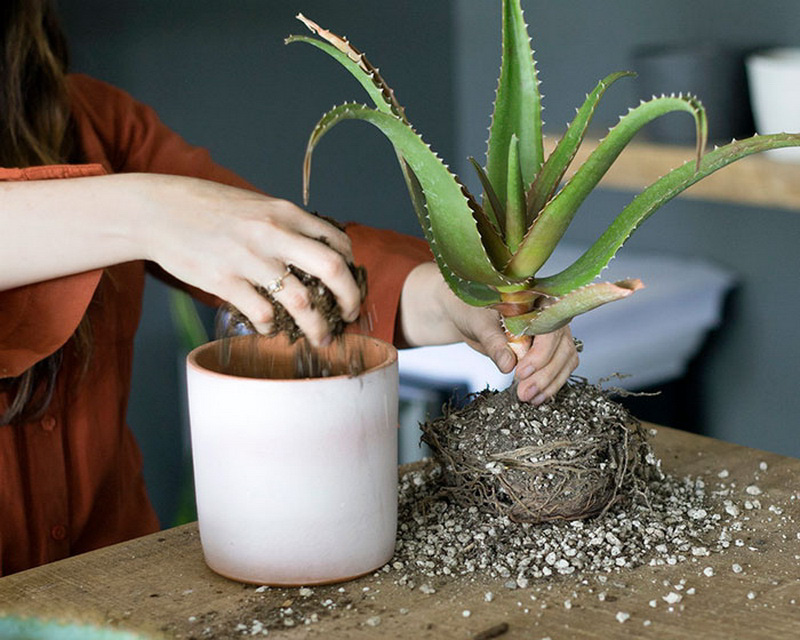
How to get a flowering plant at home?
In an ordinary city apartment, it is almost impossible to recreate the microclimate of a greenhouse for an agave. But even what you can offer a green pet at home is enough to make it bloom twice a year.
What conditions are conducive to the emergence of buds?
- Lighting: Place the aloe on the sunniest windowsill. From October to mid-April, the plant is illuminated with a fluorescent lamp or a conventional energy-saving lamp 12 hours a day, starting in the morning. The more light the aloe receives, the brighter its flowers.
The use of windows overlooking the balcony for growing agave is permissible only with additional lighting of the plant with special lamps.
- Temperature: It is unrealistic to provide seasonal and daily temperature fluctuations in an apartment. But usually it is enough to put aloe under the window, which is regularly used to ventilate the room.
- Ventilation: You need to ventilate the room where the agave grows daily throughout the year.
- Watering: Aloe loves watering in the pan of the pot, provided that during transplanting you put a large layer of expanded clay drainage on the bottom. A little water needs to be poured into the pot from above. This speeds up the absorption of moisture from the pallet into the soil. After the surface of the soil dries up, it is necessary to water it, having waited another 1-2 days. In the conditions of an apartment, watering in winter is reduced slightly. Only by reducing the rate of drying of the soil in the pot.
- Substrate: If it is not possible to make a soil mixture according to all the rules, you can prepare the land in the park, but add a little more sand and charcoal.
- Transplanting: Transplanting aloe is recommended only if its growth has slowed down due to the tightness of the pot.
- Top dressing: It is preferable to use fertilizer for succulents 1-2 times a month during the growing season. In our climate, aloe blooms in March and October. It is advisable to feed the plant 3-4 weeks before the expected flowering period.
If you decide to grow an agave, then you should learn about reproduction, medicinal properties and contraindications for use, as well as the differences from aloe vera.
Interesting Facts
This plant is not only graceful and beautiful, it is of immense benefit. In the room where the flower is located, the air is cleared, it becomes much easier to breathe, and the inhabitants of the house improve their health, troubles and sorrows recede.
Aloe is able to protect the inhabitants of the apartment where it grows from failures, troubles and ailments. If a sick person hangs agave leaves in a bag around his neck, the disease will soon recede. It is believed that the flower attracts love. A girl who wants to get married as soon as possible can speed up what she wants by performing the following ritual:
- it is necessary to carefully cut 13 leaves from the plant, having previously asked for his forgiveness;
- the leaves are placed in a dark, dry place for 13 days;
- dry leaves are burned, and ashes are scattered near the threshold of their apartment.
After completing the ceremony, there is no doubt about the speedy result.
Growing problems, diseases and pests
The plant is rarely exposed to diseases, but sometimes harmful insects attack the aloe. Frequent flower pests:
- The scale insects are small insects, when they appear on the stem and leaves, small brown seals are formed. To eliminate the problem, it is necessary to rinse each sheet using a solution of laundry soap.
- Spider mite - this pest can be noticed by the formation of cobwebs on the leaves. The plant becomes weak and can dry out completely. It is recommended to wipe the affected areas with an alcohol solution.
With improper care, problems often arise that slow down the growth of a flower:
- The root collar rots - such a problem manifests itself with frequent watering. To eliminate it, it is necessary to transplant the culture and reduce the frequency of watering.
- The flower does not grow - most often the clay soil is the cause of the problem. The plant should be transplanted into a new substrate with the addition of sand.
- Yellow leaves are a sign of excess fertilization. To solve the problem, the frequency of feeding is reduced to once every 3-4 months.
It doesn't take much effort to grow tiger aloe. The culture is undemanding to water and does not need pruning. Aloe leaves have medicinal properties and are often used for cosmetic purposes and folk recipes.
Varieties of aloe for home cultivation
Before you know what the conditions for growing different types of aloe, you need to understand the home varieties. Most often, agave, variegated aloe, and aloe vera are grown at home.
So, let's find out in more detail about those varieties that feel good in nature, and are also used as an indoor option:
The annual has velvety and green thorn-like leaves. Such a tree-like plant, with proper care, can live for about 20 years.
The cultivation of the aloe vera variety is popular. Such a plant has a shortened stem, and the leaves have a gray-greenish color and a grooved structure. This species has several varieties: yellow, Barbados and medicinal.
Florists often grow spinous aloe. It requires special care at home. The plant is distinguished by wide leaves with a white border, which form a large basal rosette.
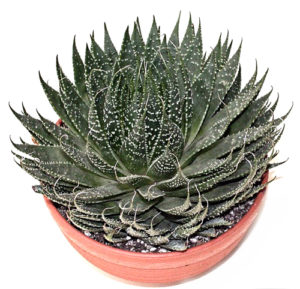 Aloe spinous
Aloe spinous
Aloe variegated is characterized by short stature and a shortened stem. It has triangular and broad leaves. Moreover, each leaf is decorated with white stripes.
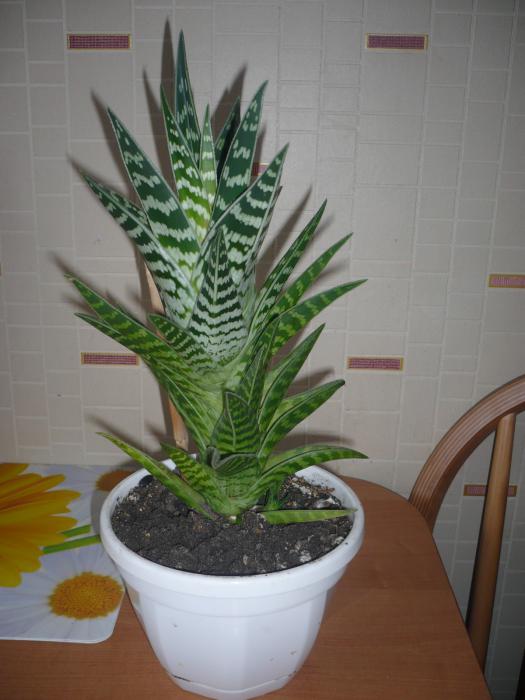 Aloe variegated
Aloe variegated
Most often, aloe vera and agave are grown for medicinal purposes. Both crops are unpretentious varieties.
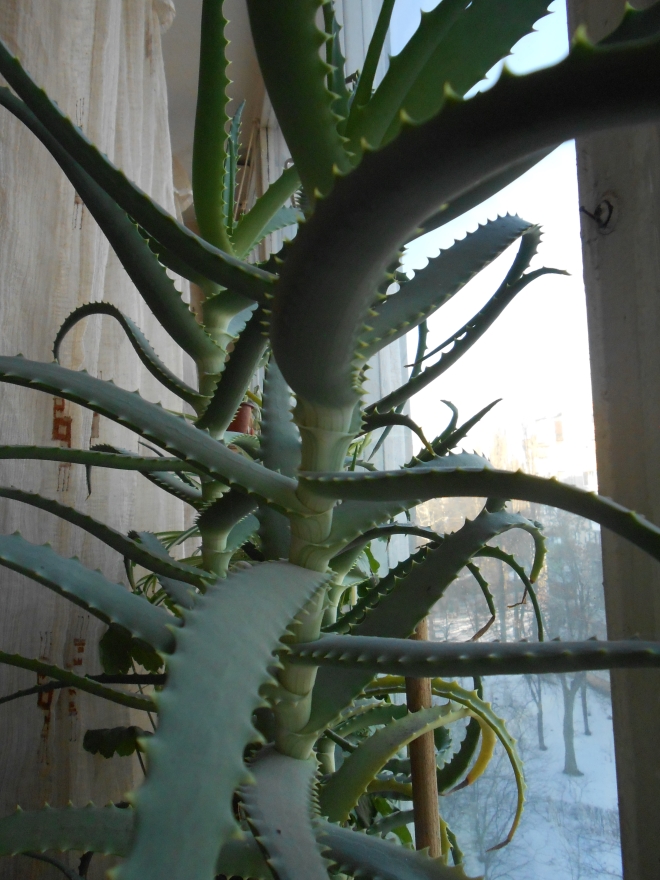 Agave
Agave
They tolerate both heat and cold well. To grow an agave and aloe vera at home, you need to know how the plant is taken care of. In addition, you need to have an idea of how to plant such a crop and how it reproduces.
 Aloe vera
Aloe vera
Can I grow with seeds at home?
This method requires patience and care. The seeds can be purchased at any specialty store. It is impossible to obtain planting material at home - aloe Vera blooms very rarely. It is best to sow seeds in late February or early March.
Seed preparation
Based on the feedback from florists, you can purchase seeds from any manufacturer. Seeds have high rates of germination and development. They do not require preliminary preparation. But for disinfection, it is better to hold the planting material in a weak manganese solution for 15 minutes.
Step-by-step instruction
- Fill the container with ready-made universal soil mixture and water abundantly.
- Deepen the seeds by 3 cm, maintaining a gap of 1.5 cm.
- Cover the container with plastic wrap and place in a warm place. The room temperature must be + 22 ° C.
- Maintain soil moisture so that no dry earth crust forms.
- When the first sunrises appear, remove the tape. Water as needed.
- After the formation of the first 2 or 4 true leaves, make a pick. Plant the plants in separate pots using the same potting soil.
It is recommended to transplant the young one-year-old flower into a larger pot. A full bush can be obtained in 2 years.
Nuances of culture reproduction
Aloe can be grown and propagated in a variety of ways. Many beginner gardeners are interested in how to grow aloe from a leaf.
There are also other breeding methods:
- You can germinate an aloe shoot.
- There is a way of propagation by cuttings.
- Reproduction by upper shoots.
- Sometimes the seed version is used.
When propagated by seeds, they should be planted in March or April. In this case, small containers are used. First you need to prepare the soil from garden soil, turf and sand. In order for the seeds to germinate, you need to water after the soil dries.
Then the seedlings are transplanted into separate containers. Seedling care consists of moisturizing and airing. In this case, the air temperature should be within 20 degrees. Sprouts can be transplanted as soon as they are strong.
It should be borne in mind that the plant gives flowers very rarely.
For this, it is important to comply with special conditions.
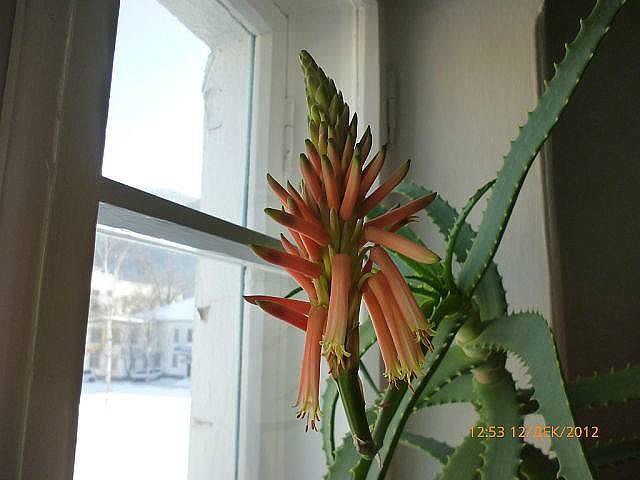
You can grow aloe from a scion without roots. To do this, the leaf or sprout must be cut off. After that, the slices should dry in the fresh air for a week. The soil for planting must be moist. This breeding option is relevant for spring or summer.
Using the top of the flower
Using the top of aloe for propagation injures the plant, but it is often used to rejuvenate an aged flower, and if its lower leaves and side shoots have already been cut off. This method is simple and easy to perform and leads to the rapid establishment of the apical process.
It is carried out as follows:
- the top must be cut off so that there are at least 7 leaves on it;
- the cut off top is dipped in a cut into a solution of phytohormone growth or another root growth stimulator and kept for 30 minutes;
- then the treated process is placed in a glass container with warm (but not hot) water;
- soon the first roots appear, and after they reach 6 cm, the rooted top is planted in the soil in a separate bowl.
Cut off the top only with a clean, sterile instrument, since the smallest contamination can provoke an infection in the flower. Some growers advise, after cutting off the top, to hold the shoot for several days in a dark room until a protective film forms, and only then put the top in water.
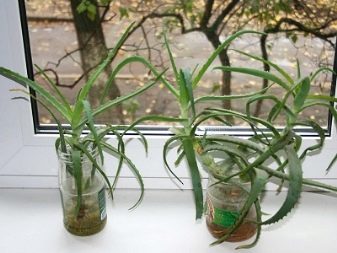
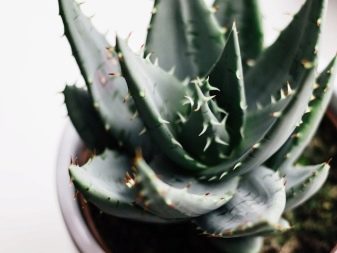
How to plant aloe properly at home
This plant belongs to the category of succulents.Therefore, aloe prefers well-lit window sills and easily tolerates a lack of moisture, since it accumulates in its leaves with rare watering. Subject to the basic requirements of the culture, this plant will not cause trouble.
Aloe is considered to be a home healer
Note! For its full development, it is important to properly land. This procedure includes several main stages. Therefore, it is worth familiarizing yourself with them in advance.
Therefore, it is worth familiarizing yourself with them in advance.
What time of year is it better to plant and is it possible in winter
Planting aloe, like other indoor plants, is best in late February - early March. It is during this period that the plant leaves the state of winter dormancy and biological processes intensify in it.
If during this period it was not possible to land, then the procedure can be postponed until the end of summer, namely until July-August. At this time, sap flow in the tissues of the plant increases, so it easily tolerates planting and quickly recovers
Important! Planting aloe in late autumn, as well as at the beginning and in the middle of winter is not recommended, since at this time the plant is at a dormant stage and will not be able to fully root, which means it will die
What land is needed for aloe
In nature, this plant can be found in countries with arid climates and nutrient-poor soil. At the same time, aloe feels great in such conditions and grows well. Therefore, it is necessary to prepare a soil for him, the composition of which will be as close as possible to the natural habitat.
You can buy a ready-made substrate at a flower shop, choosing a soil mixture for cacti and succulents. But you can also prepare a suitable soil for aloe yourself. The main thing is that the substrate is loose, light and well-drained.
To plant aloe, you will need to mix the following components:
- turf - 40%;
- leafy soil - 20%;
- coarse sand - 20%;
- small pebbles - 10%;
- charcoal - 10%.
Important! Peat should not be added to the soil, as it increases acidity, and this has a depressing effect on the roots of the plant. Soil for aloe should not be nutritious, the main thing is that moisture does not stagnate in it
Soil for aloe should not be nutritious, the main thing is that moisture does not stagnate in it.
In what container is aloe grown: pot sizes
The root system of aloe, like all succulents, is small, but the leaves are fleshy and large, since they contain a supply of moisture and nutrients. Therefore, for the plant, it is necessary to select not too deep, but wide pots. When planted in high containers, the plant will constantly turn over.
The diameter of the pot must be selected depending on the age of the seedling
At the initial stage of growth, the width of the planting container should be within the range of 8-9 cm.With subsequent transplants, it can be increased by 2-3 cm.
For your information! You cannot immediately plant aloe in too large a container, as the excess soil in the pot will begin to acidify and provoke rotting of the roots.


